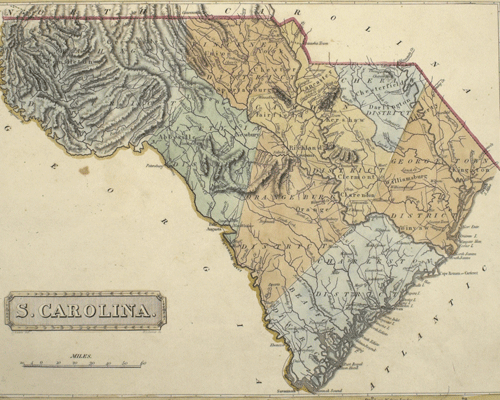Results navigation
Results navigation

On May 23, 1788, South Carolina became the eighth state to ratify the Federal Constitution. Although there was considerable opposition from the backcountry region, representatives from the capital, Charleston, and the surrounding lowcountry regions prevailed. This division in state politics would continue until a series of compromises were completed in 1808 balancing the representation of the two regions.
A new state constitution was adopted by the South Carolina General Assembly in 1790. This document preserved the weak executive structure that dated back to before the American Revolution. For example, the governor did not possess veto power after 1790. The governor and lieutenant governor were each elected to a two-year term and were then required to not hold the office for four years before being eligible for election again. The General Assembly was comprised of two branches, the House of Representatives and the Senate. Both bodies were elected by popular vote. Members of the House of Representatives served two-year terms. There were a total of 124 members whose districts were determined by a combination of population and the amount of taxes generated. It was through electoral innovations like this that the lowcountry region maintained its political dominance even though it possessed a minority of the state’s white population. Senators were elected to four year terms.
The most significant political issue in the state during this period was balancing the interests of the lowcountry and the backcountry. Under the Constitution of 1790, the state capital was moved from Charleston, on the coast, to Columbia in the interior. Eventually, the lowcountry representatives agreed to other Constitutional amendments which increased the number of electoral districts in the backcountry region and led to a greater balance of political power.
The Federalist Party dominated South Carolina in the 1790s as it could count a number of prominent lowcountry planters among their ranks. Many South Carolinians played important roles for the Federalist Party at the national level. The Jeffersonian-Republicans, however, were rising in prominence, especially as Charles Pinckney and Pierce Butler, both of whom signed the Constitution for South Carolina, joined the rival party. Although the Federalists dominated the state until 1800, by 1804 there were no Federalists in power. South Carolina would remain a one-party state until the start of the Civil War.
The Constitution of 1790 eliminated the religious qualification for voting and holding political office in South Carolina. All free, white men who were 21 years of age, had lived in the state for two years, was a resident of the district in which he was voting, owned fifty acres of land or a town lot and paid taxes were eligible to vote. In 1810 an amendment to the state constitution eliminated the property qualification for voting, extending suffrage to all white men who had lived in the state for six months. Thus, South Carolina was among the very first states to allow universal white male suffrage.
Bibliography
- James Banner
“The Problem of South Carolina” in Stanley Elkins and Eric McKittrick,The Hofstadter Aegis: A Memorial. (New York: Alfred A. Knopf, 1974) 60-93. - Walter Edgar,
South Carolina: A History (Columbia: University of South Carolina Press, 1998) - Lacy K. Ford,
The Origins of Southern Radicalism: The South Carolina Upcountry, 1800-1860 (New York: Oxford University Press, 1991) - Rachel Klein,
Unification of a Slave State: The Rise of the Planter Class in the South Carolina Backcountry, 1760-1808 (Chapel Hill: University of North Carolina Press, 1990). - George C. Rogers,
Evolution of a Federalist: William Loughton Smith of Charleston , (Columbia, SC: University of South Carolina Press, 1962). - C. Blease Graham, South Carolina’s Constitutions
- South Carolina Information Highway – Governors
Electoral College
Elector: A member of the Electoral College chosen by the several States to elect the President and Vice-President.
Oxford English Dictionary
See President of the United States for the votes cast by the Electoral College for President.
Historical Note: These elections were vastly different from modern day Presidential elections. The actual Presidential candidates were rarely mentioned on tickets and voters were voting for particular electors who were pledged to a particular candidate. There was sometimes confusion as to who the particular elector was actually pledged to. Prior to the 12th Amendment, electors were pledged to two candidates as there was no distinction made in the Electoral College between President and Vice-President.
1789 - 1824: Alabama, Connecticut, Delaware, Georgia, Illinois, Indiana, Kentucky, Louisiana, Maine, Maryland, Massachusetts, Mississippi, Missouri, New Hampshire, New Jersey, New York, North Carolina, Ohio, Pennsylvania, Rhode Island, South Carolina, Tennessee, Vermont, Virginia
State Breakdown for Election of Members to the Electoral College:
Alabama: Legislature (1820), Popular Vote (1824)
Connecticut: Legislature (1789-1816), Popular Vote (1820, 1824)
Delaware: Popular Vote (1789), Legislature (1796-1824)
Georgia: Legislature (1789, 1792, 1800-1824), Popular Vote (1796)
Illinois: Popular Vote by District
Indiana: Legislature (1816, 1820), Popular Vote by District (1824)
Kentucky: Popular Vote by District
Louisiana: Legislature
Maine: Popular Vote by District
Maryland: Popular Vote (1789, 1792), Popular Vote by District (1796-1824)
Massachusetts: Popular Vote (1789-1796, 1804, 1824), Legislature (1800, 1808, 1816), Popular Vote by District (1812, 1820)
Mississippi: Popular Vote
Missouri: Legislature (1820), Popular Vote by District (1824)
New Hampshire: Popular Vote (1789-1796, 1804-1824), Legislature (1800)
New Jersey: Legislature (1789-1800, 1812), Popular Vote (1804, 1808, 1816-1824)
New York: Legislature
North Carolina: Legislature (1792, 1812), Popular Vote by District (1796-1808), Popular Vote (1816-1824)
Ohio: Popular Vote
Pennsylvania: Popular Vote (1789-1796, 1804-1824), Legislature (1800)
Rhode Island: Legislature (1792, 1796), Popular Vote (1800-1824)
South Carolina: Legislature
Tennessee: Popular Vote by District
Vermont: Legislature
Virginia: Popular Vote by District (1789-1796), Popular Vote (1800-1824)
Office Scope: Federal
Role Scope: State / District






